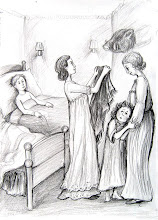Koutsantoni, Katerina. "We must remain Readers." Virginia Woolf's Common Reader. Surrey: Ashgate Publishing Limited, 2009. 101-122.
Koutsantoni exposes the fact that Virginia Woolf did not like to be “led by the nose… by authority” (75). When Woolf created her literary works she went against what the society of her time dictated. As a writer Woolf referred to the authoritative figure as the “aristocrats” and their mannerisms. Much of the dissatisfaction that Woolf experienced from this circle of people came from the way that they became oppressive and imposed themselves over the rest of society. In her rebellion, Woolf crafted her writings to demonstrate that she was opposed to their way of thinking. She used her writing as a way to expose and transmit the feelings that the public had. As a woman, Woolf was expected to surrender judgment and “defer to superior knowledge” (81). Because she was a woman that had power and authority over her life and her decisions, but was constantly under the oppression of men in power, she found that the best and only way to allow her anger and frustration toward the system that she lived under was to write and allow her characters to experience the same feelings she possessed. Because of the dominance that men had over the world that she lived in, she still experienced limited access to the academic institutions that were geared toward professional writers. In her creative mind Woolf allowed the female characters to be authoritative. Mrs. Ramsay was one example of authoritativeness. She was a dominating person, when she spoke whatever she said was done, and as Koutsantoni notes, even the figure of her and James on the window projects her as a woman with authority.
Reading this passage allows the reader to become more aware of the nature and point of view that Virginia Woolf had about her society. Understanding the oppression that she felt from people around her can help us better relate to Lily Briscoe’s character. Because of Woolf’s gender there were limitations in many of the things she could and would choose to do, like writing in an era where women were expected to be mothers and wives as opposed to artists. As she did these things she was criticized, with this in mind we are able to grasp the reason behind the thoughtful process and constant evaluation that Lily goes through in the novel when painting. Lily thinks about her ability to create art and her need for finishing her painting before marrying someone; the rest of the male and female figures presented in the novel do not dominate her. In the same manner Woolf allows herself to be in charge of her own life without letting the influence of others affect her decisions. When creating her painting Lily is criticized and oppressed by almost everyone, including Mrs. Ramsay. Lily looked up to Mrs. Ramsay and hoped to be able to someday become like her, but after realizing what that would automatically require, leaving her painting to tend to a husband and raise children, she opts for continuing in her path to self fulfillment. Through Lily’s artistic process, by proving to herself that she can accomplish her painting, the reader can view Woolf’s determination and stream of thought allowing him, the reader, to experience the narrative style she used in a more personal manner.
Friday, December 11, 2009
Subscribe to:
Post Comments (Atom)



No comments:
Post a Comment